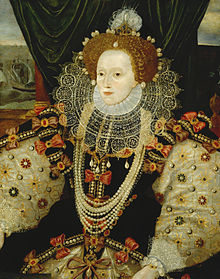
Back العصر الإليزابيثي Arabic Елизабетинска епоха Bulgarian Època elisabetiana Catalan Oes Elisabeth Welsh Elisabethanisches Zeitalter German Ελισαβετιανή εποχή Greek Elizabeta epoko Esperanto Época isabelina Spanish Elizabethi ajastu Estonian Isabeldar Aroa Basque
| Elizabethan era | |||
|---|---|---|---|
| 1558–1603 | |||
 | |||
| Monarch(s) | Elizabeth I | ||
| Leader(s) |
| ||
Chronology
| |||
| Periods in English history |
|---|
| Timeline |
The Elizabethan era is the epoch in the Tudor period of the history of England during the reign of Queen Elizabeth I (1558–1603). Historians often depict it as the golden age in English history. The symbol of Britannia (a female personification of Great Britain) was first used in 1572, and often thereafter, to mark the Elizabethan age as a renaissance that inspired national pride through classical ideals, international expansion, and naval triumph over Spain.
This "golden age"[1] represented the apogee of the English Renaissance and saw the flowering of poetry, music and literature. The era is most famous for its theatre, as William Shakespeare and many others composed plays that broke free of England's past style of theatre. It was an age of exploration and expansion abroad, while back at home, the Protestant Reformation became more acceptable to the people, most certainly after the Spanish Armada was repelled. It was also the end of the period when England was a separate realm before its royal union with Scotland.
The Elizabethan age contrasts sharply with the previous and following reigns. It was a brief period of internal peace between the Wars of the Roses in the previous century, the English Reformation, and the religious battles between Protestants and Catholics prior to Elizabeth's reign, and then the later conflict of the English Civil War and the ongoing political battles between parliament and the monarchy that engulfed the remainder of the seventeenth century. The Protestant/Catholic divide was settled, for a time, by the Elizabethan Religious Settlement, and parliament was not yet strong enough to challenge royal absolutism.
England was also well-off compared to the other nations of Europe. The Italian Renaissance had come to an end following the end of the Italian Wars, which left the Italian Peninsula impoverished. The Kingdom of France was embroiled in the French Wars of Religion (1562–1598). They were (temporarily) settled in 1598 by a policy of tolerating Protestantism with the Edict of Nantes. In part because of this, but also because the English had been expelled from their last outposts on the continent by Spain's tercios, the centuries-long Anglo-French Wars were largely suspended for most of Elizabeth's reign.
The one great rival was Habsburg Spain, with whom England clashed both in Europe and the Americas in skirmishes that exploded into the Anglo-Spanish War of 1585–1604. An attempt by Philip II of Spain to invade England with the Spanish Armada in 1588 was famously defeated. In turn England launched an equally unsuccessful expedition to Spain with the Drake–Norris Expedition of 1589. Three further Spanish Armadas also failed in 1596, 1597 and 1602. The war ended with the Treaty of London the year following Elizabeth's death.
England during this period had a centralised, well-organised, and effective government, largely a result of the reforms of Henry VII and Henry VIII, as well as Elizabeth's harsh punishments for any dissenters. Economically, the country began to benefit greatly from the new era of trans-Atlantic trade and persistent theft of Spanish and Portuguese treasures, most notably as a result of Francis Drake's circumnavigation.
The term Elizabethan era was already well-established in English and British historical consciousness, long before the accession of Queen Elizabeth II, and generally refers solely to the time of the earlier Queen of this name.

- ^ From the 1944 Clark lectures by C. S. Lewis; Lewis, English Literature in the Sixteenth Century (Oxford, 1954) p. 1, OCLC 256072
© MMXXIII Rich X Search. We shall prevail. All rights reserved. Rich X Search